|
Posted by Romy the Cat on
06-09-2006
|
|
Sine my call for somebody builds for me a full range Melq was not answered:
http://www.goodsoundclub.com/TreeItem.aspx?postID=2492#2492
I decided to put it together myself. Now I understand that letting the first amp to go was a mistake. There is something very special in a single channel full-range Melquiades. The Super Melq is fine but it bound to the Macondo. The full range Melquiades suck totally deferent life from OTHER speakers and I would like to have this experience available.
So, I am starting slowly to make another Melq. It might be even better as I would not bitch to anybody that they do the thing “different”. I will be posting the incremental pictures while the amp will be assembling.
Rgs,
Romy the caT
|
|
|
|
Posted by Romy the Cat on
06-09-2006
|
|
Ok, it took 2.5 hours to mount the transformers and chokes. The transformers above are filament transformer and high voltage transformer. (The super Melq has all high voltages coils as separate transformers). The 3 chokes above are input chokes for first stage, negative supply and positive supply. The large choke inside the chassis is the 10H/500mA choke for second stage. The power entry is the regular Schurter, fused but not filtered. The fan is SilenX Ixtrema 120 11dBA and will be running at 5V. The single building post (no multiple taps) are unavoidably by Superior Electric.
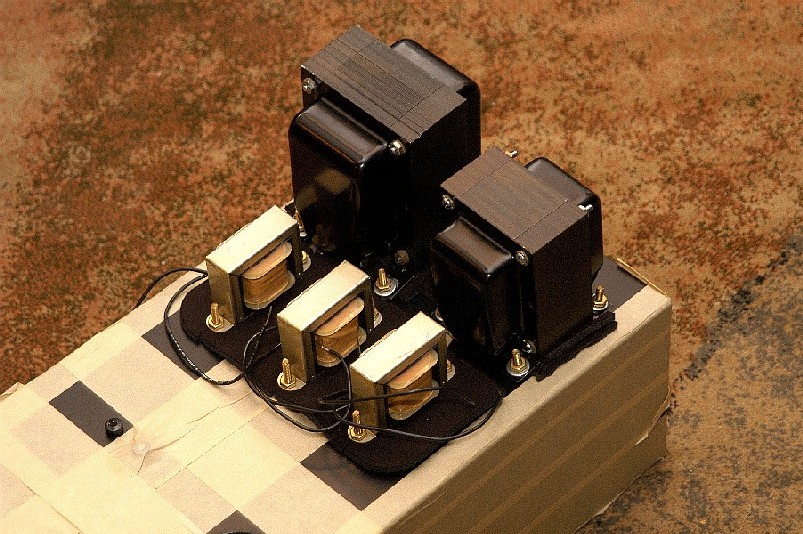
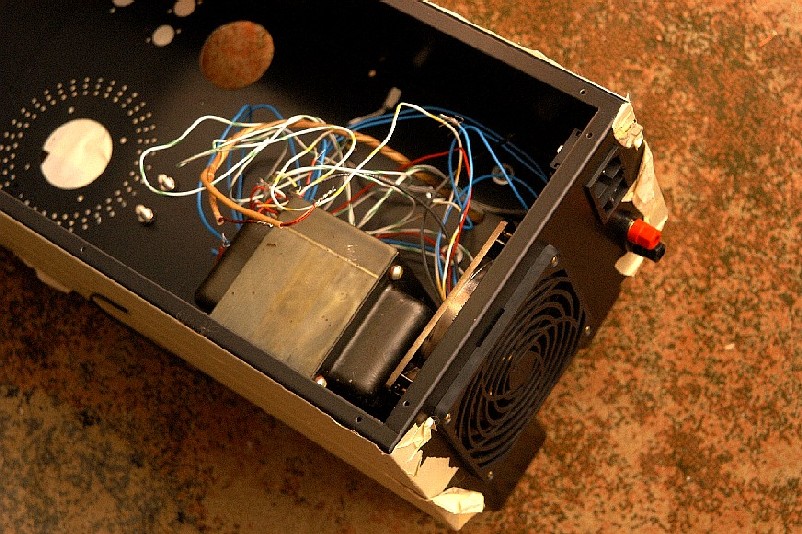
It was slight pain in ass to mount all of it as the big power choke and power transformers are mounded against each other. The Power transformers are lifted form the chassis. I experimented with different vibration dumpling materials in past and use some crazy things. However, what I discover that regular rubbers mostly convert the vibration into LF vibration. So, I use a layer of sorbothane (1/4 under PS transformers and 1” under the big choke) and a few layers (above and under sorbothane) of proprietary, demilitarized, highly secretive VibroSponge ™. The VibroSponge ™ works magnificent, at least my stetoskop indicates it.
Rgs,
Romy the Cat
PS: The VibroSponge ™ of course is not the demilitarized crap but the regular, the cheapest, black mouse pads from my local Micro Center. They cost $1.20 and it happen that they, although they might look ugly but they “work” very very nice, better then the identical thinness of the different high-tech rubbers.
|
|
|
|
Posted by hagtech on
06-11-2006
|
I was going to ask you about that funny looking damping material. Then you explained it at bottom of post. Very clever to use mouse pads! Lately I've been using cork & buna rubber sheets from McMaster-Carr. Seems to work much better on chassis then the regular spongey rubber. I suppose it all depends on application. For feet I still use sorbothane.
Question, do you put anything on the inside of the chassis? I find it sort of works like tube dampers. Strips of adhesive backed rubber (or the cork stuff) along the inside rims help to remove any ping. Like a loudspeaker or turntable, it's a compromise between too much liveliness and overdamped and dead.
One more thing, try remove the shit steel screws from the power transformers and replace them with stainless steel or brass.
jh
|
|
|
|
Posted by Romy the Cat on
06-11-2006
|
 hagtech wrote: hagtech wrote: | | Iwas going to ask you about that funny looking damping material. Then you explained it at bottom of post. Very clever to use mouse pads! Lately I've been using cork & buna rubber sheets from McMaster-Carr. Seems to work much better on chassis then the regular spongey rubber. I suppose it all depends on application. For feet I still use sorbothane. |
|
The magnetics themselves are quite quiet. The transformers are by Electro Print and they are fine. The chokes are by Hammond as Electro Print does horrible input chokes – they just do not handle high ripples and buzz like hell. Ironically the Hammonds, even though they nether specially warnished their chokes nor bake them, but they are completely silent in input choke application (30H and 40H). Also I’m attracted to Hammonds because the Hammonds choke had high DCR. I have no idea why but I experimented with few “better quality” chokes with lower DCR and detected that the reasonably higher DCR of the input choke produce better sound (with the same output impedances of the entire PS chain). The big choke of the B+ is a different type or problems as whatever I tried created some minor buzz when I use high plate current on the 6C33C. I end up ordering from Hammond a custom version of the choke that they call “Ripley”. The Ripley chokes are ~25% more expansive and take a month or two to make but they are completely silent, regardless of current they care. The Ripley are made by submerging the chokes in a bath of epoxy twice: first time then the coils is made and the second time when the entire choke is built. The Ripley looks ugly, it look like someone vomited on your choke, but they very silent in operation while high ripples applied to them.
Anyhow, returning to the subject: I find that it is not only the providing the elastic or vibration-dumpling material between the magnetics and chassis but it also about lifting of magnetics from chassis. Since I used steel chassis the deferent peaces of magnetics, working against the same steel chassis induce in the chassis some vibrations. The easier way is not to use steel chassis bit it has own merit in case of a single Melq. I fought with the stray fields in Super Melquiades’s power supply as the Super Melq has much more transformers/chokes and they are all run at higher current (I foolishly used a steel chassis in the Super Melq’s PS). Anyhow, I was not able to resolve the problem in there and was forced to use stupid “brutal force anti-dumping”. In case of a regular Melquiades just the simple lifting the magnetics from the chassis do the very necessary things. Sure, if to make it “properly” then it would be nice to encapsulated the magnetics in the cans where the magnetics would be suspended in patting and would not have any mechanical contact with chassis. It is not difficult to do but the way in which I have designed the chassis did not make this provision. Since I had a pair of made chassis I decided to do it as the original first amps was made and do not change anything.
 hagtech wrote: hagtech wrote: | | Question, do you put anything on the inside of the chassis? I find it sort of works like tube dampers. Strips of adhesive backed rubber (or the cork stuff) along the inside rims help to remove any ping. Like a loudspeaker or turntable, it's a compromise between too much liveliness and overdamped and dead. |
|
Nope, I do not use any explicit dumping inside of the chassis but I have plenty of “accidental” dumping. It will be a few large parts inside, like large capacitors (250V/15.000uF, 450V/4.700uF and so on). Before I mounted them to chassis via their bolted harnesses. Then I begin to use the “lazy-man mounting”. I got in Home Depot a black silicon sealant and created a silicon bathes for the large parts if it applicable. When silicon solidifies it holds very nice but still has some elasticity that works as a magnificent dumping for the entire chassis. It might look quite ugly and has no “manufactured feel” but it VERY functional and purposeful as besides the damping it also isolates the temperature of the cap from the temperature of the chassis. I like the silicon mounting…
 hagtech wrote: hagtech wrote: | | One more thing, try remove the shit steel screws from the power transformers and replace them with stainless steel or brass |
|
Good idea, I did not think about it but it perfectly makes sense. This is exactly why I publicized the Melq’s progress: because someone might point out some educational advise how to make the things better. I appreciate it…
Rgs,
Romy the Cat.
|
|
|
|
Posted by hagtech on
06-12-2006
|
Yes, steel chassis can be both good and bad. It likes to conduct magnetic fields, so you have to treat things appropriately. A little spacing under a choke can go a long way. Otherise you have a 120Hz motor. I have another trick that helps with the far field. The stray magnetic spray from the Hammond chokes is pretty big. Helps to measure it to see which directions it has maxima and minima. Then you mount the coil with the proper aim. Usually away from the input tubes. My trick is to use two chokes instead of one. Wire them up in parallel or series, then mount them side-by-side and magnetically out of phase. You get quite a bit of far field cancellation. I did this in the Trumpet.
I like your idea of double-dipping the chokes. I wonder what can be done to stock chokes.
My friend Uncle Stu, who told me about the tranny bolts, also says you can get some improvements with the screws used to mount the speaker drivers. Not sure how this applies to horns. Anyway, the idea is to keep magetically influenced materials away from the voice coil. Personally, I have not been able to hear a difference, but he says he can. I've learned over time not to doubt his ears.
Silicone glue is great. Insulating too. It wasn't strong enough for my S&B step-up cans, so I use a giant wad of epoxy. Not the softest mounting, but way better than a friggin steel clamp.
As far as high ESR, I'm actually quite relieved you prefer the high dc resistance. There are several arguments going on over at AA about using super low DCR inductors. Shoot, I said to myself, I've been doing exactly the opposite! Not only do I use the highest DCR choke I can find, but sometimes even add to that externally. It's all tuned, of course, for critical damping. I found it to work great. Very stable, keeps line noise out. So maybe the AA guy is crazy? Heck, even in my low cost circuits, my RC supply filters often use pretty darn high values of R. For me, I have no problem burning a sheetload of power.
jh
|
|
|
|
Posted by Romy the Cat on
06-12-2006
|
 hagtech wrote: hagtech wrote: | | Yes, steel chassis can be both good and bad. It likes to conduct magnetic fields, so you have to treat things appropriately. A little spacing under a choke can go a long way. Otherise you have a 120Hz motor. I have another trick that helps with the far field. The stray magnetic spray from the Hammond chokes is pretty big. Helps to measure it to see which directions it has maxima and minima. Then you mount the coil with the proper aim. Usually away from the input tubes. My trick is to use two chokes instead of one. Wire them up in parallel or series, then mount them side-by-side and magnetically out of phase. You get quite a bit of far field cancellation. I did this in the Trumpet. |
|
Very good idea. I use in Super Melquiades another way to deal with the problem. Since it was a separate PS chassis I did not care a lot about the “away from the tubes”. However, since I had zillion transformers and chokes on it I got my chassis sing as a good contralto. Whatever I tried (lifting, turning, bagging, playing) did not make it silent. I was at the verge to rebuilding it with none-magnetic material but then I invented a “brutal force damping”. I took a heavy wooden stick and began to hard-push the PS’s chassis until I found a point where the pressure was able to change the chassis noise. They I drove a large ¾ bolt, 5 inch long across the entire chassis. After this I turned the amp and by slowly screwing the nut on the damping's bolt I was able to comfort out the noise from the chassis. Next time I will be smarter and I would never make PS with steel chassis. (I hope it will be no "next time")
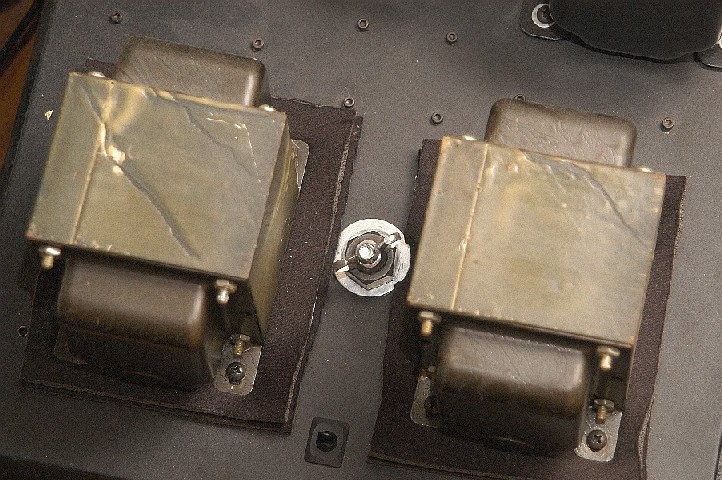
The Ripley Chokes and the "Brutal force damping" device on the Super Melquiades PS...
In fact when I next time open this 100 pounds monsters I will try to turn the chokes opposite to each other trying to do what you do.
 hagtech wrote: hagtech wrote: | | I like your idea of double-dipping the chokes. I wonder what can be done to stock chokes. |
|
So do I wonder! I have quite few good inductors that just too nosy in the input choke applications. If I were serious about the building then thing then it would not be difficult to bake them of to dip them in mozzarella… BTW, if you cal to Hummond and order the Ripley version from Sales then they most likely would not know what it is. You have to talk to the tech support there and ask them to explain to a sale person what would it be. I was waiting my 6X500mA/10H chokes for 4 months as the damn sales people did not believe that they exist and they keep sent me the regular one. BTW, before the 1992 the single deep into epoxy was a standard Hammond procedure for the chokes over 100mA.
 hagtech wrote: hagtech wrote: | | So maybe the AA guy is crazy? |
|
With my legacy at the AA sewers do you need to ask ME this question?
Rgs,
Romy the caT
|
|
|
|
Posted by Romy the Cat on
06-20-2006
|
|
OK, the next step is kind of done. All transformers and chokes are done form “outside” of the amp (under the bulge). I have attached the capacitors and the output transformer to the “inside”. This silicone attachment that for the computer grade caps the previously mention in this thread might be does not look sexy or “commercial” but in realty it works absolutely the best then any other mounting method as it dumps the chassis and heat isolates the capacitors.
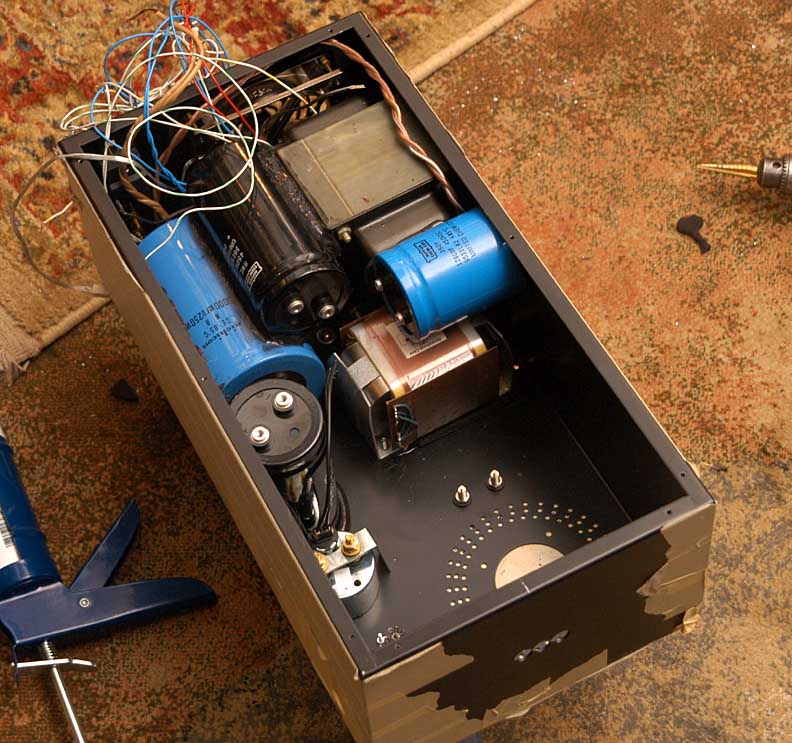
A few words about the heat management inside of the amp…. The entire amp is sealed and has only one input and one out holes. Input is taken care by a filtered fan that you can see on the back. (it is very quite and it is decoupled form the chassis). The air then thrown out via those small holes around the 6C33C. The caps that you se in the picture looks like mount very closely but in realty they do have enough space between then to allow the air flow. All large caps are 85C. The output transformer is amorphous Lundahl LL1627 in “D” configuration.
Rgs,
The Cat
|
|
|
|
Posted by Romy the Cat on
06-21-2006
|
|
Building the Melquiades: #3
Spent last might 3 more hours to pile up in one of the Melq the rest of the parts. It looks like now all detachable parts are there. Whatever parts have no assess anymore are wired and the main ground is in place. Pretty much not is left only to wire the parts.
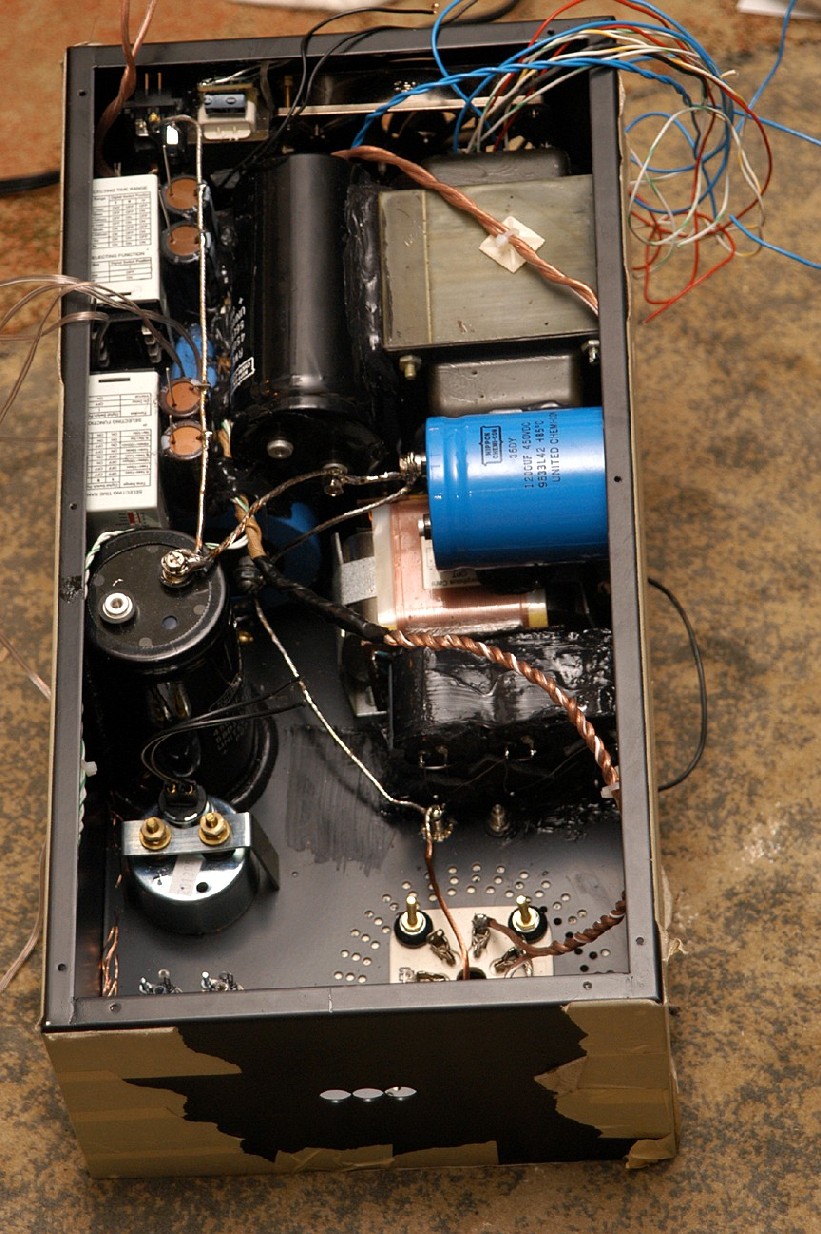
Now the Melq has separate PS for the fan, two delay circuits, 15.000uF of second stage, 7.200uF for first stage, 9.000uF for negative bias (very critical) and 1.200uF for positive bias. All 3 separate power supplies (except fan of course) have choke inputs.
I am very like the louse as I find it quite practical. It might not look sexy but I find it superbly functional within the given space limitation....
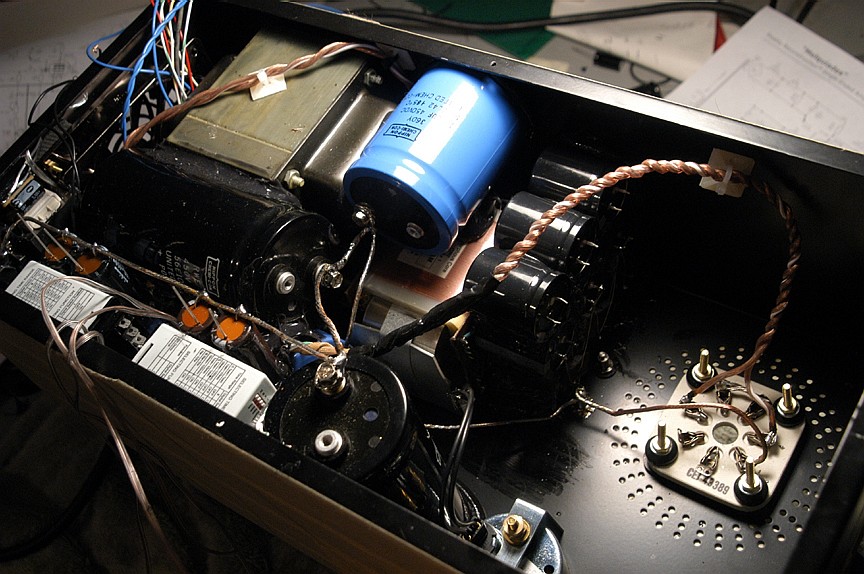
I received some emails form the people who are contemplating Melquiades and asked about the cost of the amp. I think the cost is around $1.500 per monoblock but I intentionally made it expansive using some radicalism, I might be done under 1000 without a serious damage for performance, or even lower.
Rgs,
The Cat
|
|
|
|
Posted by Romy the Cat on
06-22-2006
|
|
Spent quite a few hours last day to connect the transformers, rectifiers, chokes, filters, decided do not got for the bleeders but for more henries in the chokes. It works fine so far. Ironically and very much contrary to my expectations I do enjoy to make this Melq. I remember that the first Melq it took 3-4 month to perfect, including many changes. This one it being made as it should be as there is not design controversy. I hate to say it but I have almost fun. Now it will be more fun it somebody else build a second channel for me….
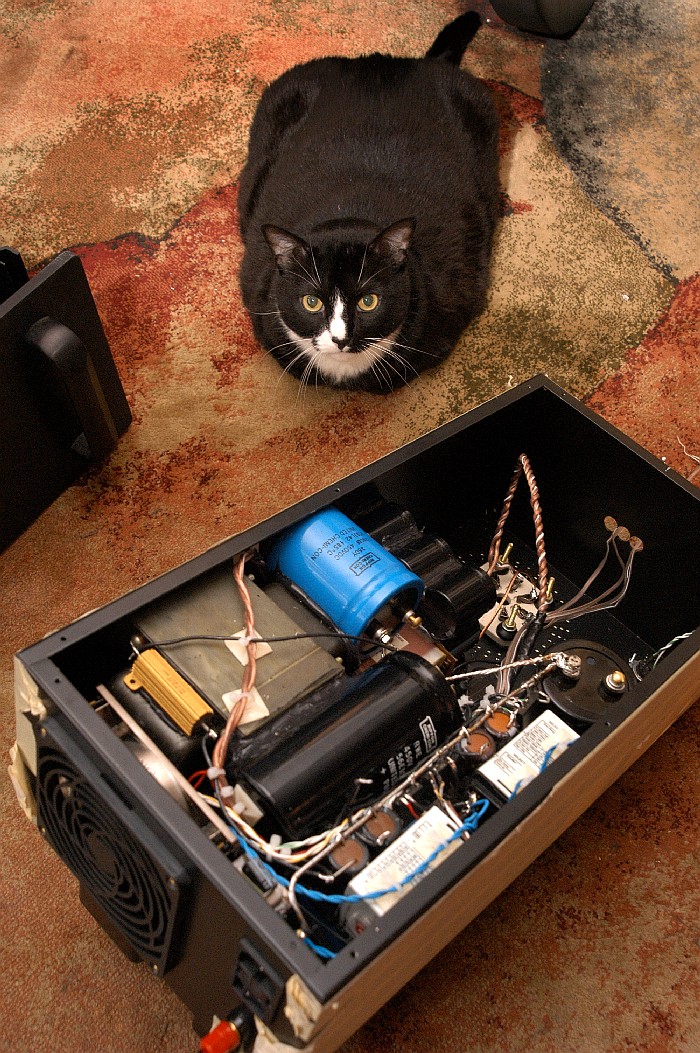

The Cat
|
|
|
|
Posted by Romy the Cat on
06-23-2006
|
|
Ok, the one channel of the Milq is up and running. The first assembly went fine, no bugs or problems – it worked fine juts after the build. All voltages, delays and heating are normal; this I would need to inspect everything again after it will work for a while. For this amp I decided to drive the 6C33C at full power at near 60W.
Preliminary I feel that this Milq has more powerful bass then the first one. I did not measure it but subjectively it is very notable. Also, it is insultingly quite. With none-shorted input it measures .4mV at the output – not bad…. The powers supplies do fine worked fine: all chokes are triple and more of the minimum inductance and looking at the scopes like they are agreeable with rectifiers output. The ripples are very low, way under 1mv. I particularly proud about the cooling: in a sealed enclosure with forced air it is possible to do some kinky things…..
Sound…. I am not exactly impressed, in fact it kind of sounds ugly. I care at this point about it as it is juts too new amp to say anything defiantly, not to mention that some things should be change to listen Sound: I run now the “dead tubes” for first and second stage (my building test tubes), I did have better good resistor for plate of the first stage, I have no input loading resistor in the amp and load the preamp and cable to the gas tubes… So, beside it is too new it also has own reasons to sound “straggly”… Oh, yes did I mention that I am driving for now the new Milq with loudspeakers of 82dB sensitively?

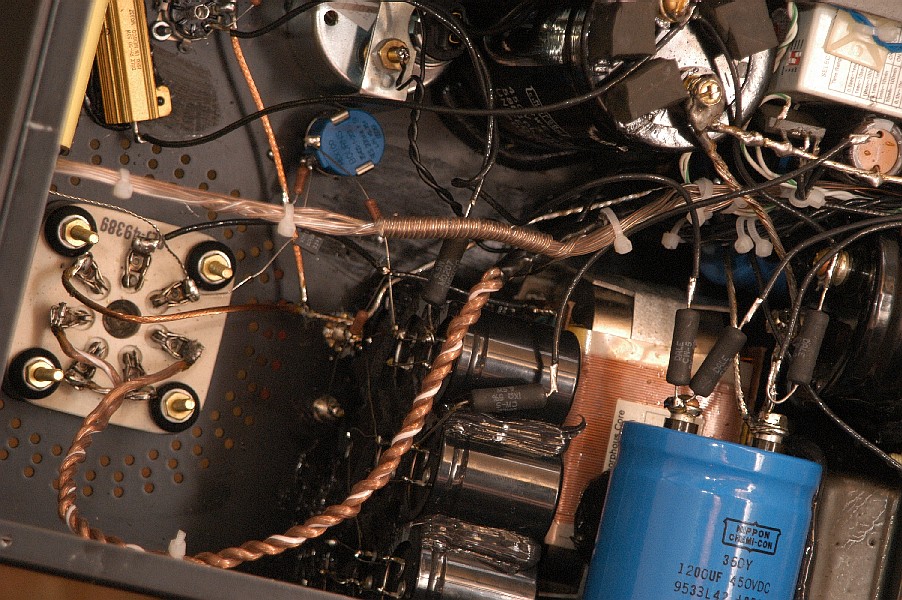
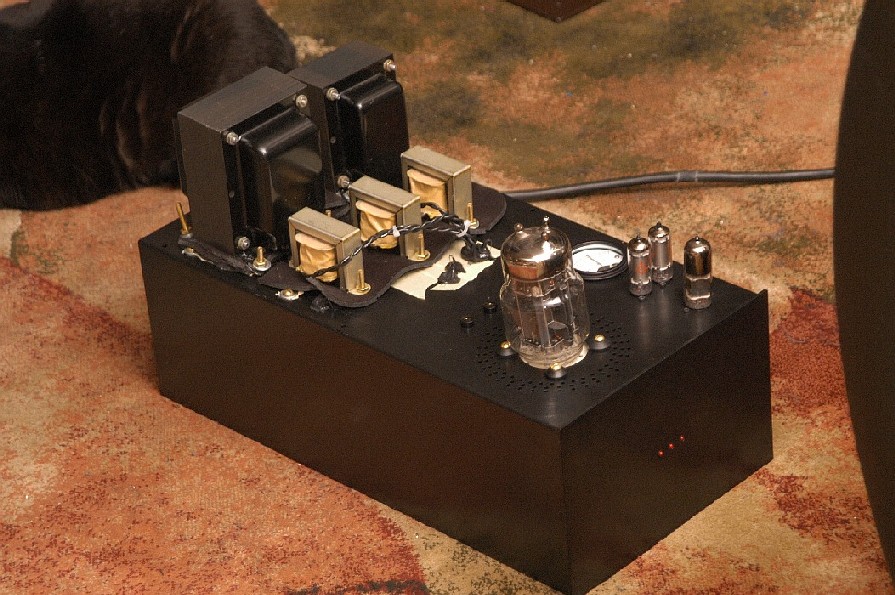
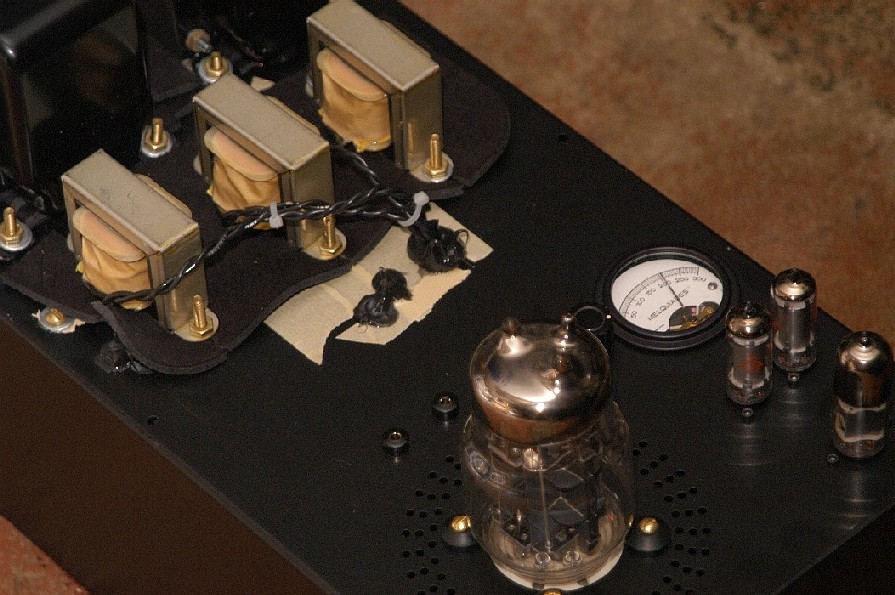
Anyhow, it looks like there is a light in the end of this Milq tunnel and if everything goes fine then I will close it up this weekend. This monoblock took has approximately 16 hours to bring it to the state it is. It was a nice and not abusive process. In fact, it was the only project of mine during which, I did not electrocute myself of burned my fingers. Although the project is not over….
Rgs.
Romy the Catn
|
|
|
|
Posted by hagtech on
06-24-2006
|
Wow, you sure do pack it in there! I like the way you silicone the caps and other things into place. Maybe you can do the same for the bleeder resistors and wiring bundles? That is, once you are sure it is operational. Wires can be like guitar strings.
The twist on the heater wires is a little tight. You can actually take this too far. A medium twist seems to have best cancellation of mag fields. Like maybe 2 turns per inch. Hard with such thick insulation.
I've also heard that black insulation is the worst. I have yet to prove this myself, but some reputable experimenters have come to the conclusion that there must be something in the black dye (carbon?) that screws it up. Other colors ok, white is best. I think it must be a dielectric thing as with capacitors. Air is best, then teflon...
jh
|
|
|
|
Posted by Romy the Cat on
06-24-2006
|
 hagtech wrote: hagtech wrote: | | Maybe you can do the same for the bleeder resistors and wiring bundles? That is, once you are sure it is operational. Wires can be like guitar strings. |
|
Actually I do some sort of things. What I am done (I’m not done yet with this monoblock) I usually drop some silicone on the intersection of the wires. Also I apply to the naked parts of chasses ever–elastic electrical patty form Home Deport. It is ugly looking, clay like patty that phenomenally dumps chasses. I stolen this idea from some manufacturers from 70s: they mounted tweeters in baffles via patty instead of gaskets. Also in this Melq I do not use any bleeder resistors. The 40H works OK in the first stage. In the bias supply I went for half way rectifier that send 30H chokes into 120Hz dropping the critical indactance. (Jack Electroptint screwed me up forgetting to put a center tap (!!!) in bias transformer and I learned about it AFTER everything was mounted and glued. Thanks, Dima save the show!)
 hagtech wrote: hagtech wrote: | | The twist on the heater wires is a little tight. You can actually take this too far. A medium twist seems to have best cancellation of mag fields. Like maybe 2 turns per inch. Hard with such thick insulation. |
|
Thanks, I will take it under consideration with second monoblock. I thought the tighter it would be the better. Dima propose a very kinky way to introduce a virtual center tap for AC hearers that drop noise form AC filaments dramatically bur this Melq turned out to be dead silent, so I did not employ anything beside juts ordinary better grounding techniques, using just common sense instead of not existing knowledge.
 hagtech wrote: hagtech wrote: | | I've also heard that black insulation is the worst. I have yet to prove this myself, but some reputable experimenters have come to the conclusion that there must be something in the black dye (carbon?) that screws it up. Other colors ok, white is best. I think it must be a dielectric thing as with capacitors. Air is best, then teflon... |
|
I did not know about it but ironically I do not use black insulation tape. If I need to use insulation I always use a tape that I use to use to tape the things to the shooting background of my studio (it un-glue form paper without damaging it). The problem with that tape that it dries out and loosing its glue-ablilety. So I apply a layer of the black electrical tape atop of my regular tape, juts to hold the thigh together….
BTW, Jim, what it your view about grounding of secondary in output transformer? I keep secondary lifted in the Super Melq as I have in there 6 phase switching relays and I did not want to think about grounds in there. In this single Melq I might ground secondary. In the past I was trying to assess it subjectively and I felt that grounded secondary sound a bit softer. I still did not reach any final decision, as this new Melq is too fresh to sound reasonable.
The caT
|
|
|
|
Posted by Romy the Cat on
06-24-2006
|
I run some sweeps on the new Melq. It looks like it is moderate, somewhere from 20-21Hz to 22-23Khz. Since I run the 6C33C at near 60W for now it is fun to see how it works. In the scope the repose and the distortion at LF looks kind of funny but I have a small transformer with juts 200mA gap in there. What is funny with this Melq that I was not able with THIS amp to drive 6C33C intentionally into temperature instability. I have some 6C33C withy very dead anode and those tubes dive into temperature instability with fixed bias even if they sit 5 feet away form power outlet. However, in this Melq I was not able to do anything to then to heat up the plate. I burned two12Ohm 12W resistors running the Melq with 5V (deep into clipping) input of 10Hz. With this stress the 6C33C plates should go crazy but to my huge surprise the anodes behaved perfectly. And it was with the verified dead tubes and slightly higher filament voltage!!!!

The caT
|
|
|
|
Posted by hagtech on
06-24-2006
|
 Romy wrote: Romy wrote: | | ...what is your view about grounding of secondary in output transformer? I keep secondary lifted in the Super Melq as I have in there 6 phase switching relays... |
|
Not sure I understand. You run the speakers floating from ground? Are you doing polarity swithing on the outputs?
First, it just doesn't seem right to me to phase switch the amplifier outputs. I'd rather do it to the inputs. Not sure I like the relay contacts on the larger currents. Of course it works. I just wonder what is being lost.
Second, I don't know if it's bad to float the outputs. Seems like maybe there will be some common mode issues. Maybe noise injection or some HF instability. Possible feedback of external noise source reflected back into primary. My personal preference is to run balanced secondary. Or more specifically, a center tap to ground (or some earthly reference). I like the balanced transmission of signal. This too, reduces any common mode interactions. I think grounding one amplifier output is a mistake brought on by cost considerations. Unfortuantely, it is near impossible to find an output tranny with the right characteristics. But to float? I wonder if you can get charge buildup or some other wierdness.
jh
|
|
|
|
Posted by Romy the Cat on
06-24-2006
|
 hagtech wrote: hagtech wrote: | | Not sure I understand. You run the speakers floating from ground? Are you doing polarity swithing on the outputs? |
|
Sure, all my secondaryes are no grounded and the speakers are floating. I do not see any technical problem with it.
 hagtech wrote: hagtech wrote: | | First, it just doesn't seem right to me to phase switch the amplifier outputs. I'd rather do it to the inputs. Not sure I like the relay contacts on the larger currents. Of course it works. I just wonder what is being lost. |
|
The super Melq has after each channels a set of two really that reverse the connection of the secondaryes to the binding posts. I do not see any problem with it as in not-balance design to flip the phase at inputs I would need one extra active stage. A good quality relay work very nice with higher current as higher current breaks thru the contacts. The relays are well-tested at line level and with speaker level and I have heard no sonic degradations.
 hagtech wrote: hagtech wrote: | | Second, I don't know if it's bad to float the outputs. Seems like maybe there will be some common mode issues. Maybe noise injection or some HF instability. Possible feedback of external noise source reflected back into primary. My personal preference is to run balanced secondary. Or more specifically, a center tap to ground (or some earthly reference). I like the balanced transmission of signal. This too, reduces any common mode interactions. I think grounding one amplifier output is a mistake brought on by cost considerations. Unfortuantely, it is near impossible to find an output tranny with the right characteristics. But to float? I wonder if you can get charge buildup or some other wierdness. |
|
Nope, I had it floated and grounded and practically have seen no difference. There is very very minor sonic differents but so minor that I would call it negligible. I left in the new Melq the secondary lifted. I might ground it eventually but I have no opinion about it so far… and so far I did not see any weirdnesses.
The Cat
|
|
|
|
Posted by hagtech on
06-24-2006
|
 The Cat wrote: The Cat wrote: | | Nope, I had it floated and grounded and practically have seen no difference |
|
Yes, I would suspect this in most installations. I guess my concern is for the rare and unusual. A floating speaker might be able to pick up common mode interference. Perhaps if you had wooden floor with live conduits flowing under it. Just thinking aloud. Or maybe something really odd, like the speaker cable acting as a long common mode AM antenna, reflecting the received signal back into the primary side of tranny where perhaps it sees some HF nonlinearity and demodulates, putting some radio signal onto the tubes. I don't know, maybe I am reaching here. Maybe something funny happens in only 1 out of 10 systems. Perhaps you have to be near an AM station pumping out 590kHz. Or have a home theatre installation with a CRT.
jh
|
|
|
|
Posted by hagtech on
06-24-2006
|
Ah, think of it this way. Imagine floating the input to your ET step-ups. Don't ground it. Let the primary and phono cartridge float. This is a similar situation but far far more sensitive. It's a mind game to make it easier to think of possible problems. I like to think in extremes.
jh
|
|
|
|
Posted by Romy the Cat on
06-24-2006
|
|
Actually I did have it is past. At that time I used a low-pass filer on my upperbass horn. It was 103dB sensitive driver of 16Ohm, highly inductive, and I needed somewhere hear 800Hz, speaker level, the first order. Being an extremist I got 3mH coil of 8ga wire. Oh, did I mention that at it was an air core coil? This barrel of corer sounded very well but the problem was that when I connected to this coil the MF driver crosier then I was picking quite a lot of noise in my speakers… even the amplifiers were disconnected. Interesting that the noise was irrelevant to grounds or anything else and grounding it did not resolve the problem. Moving the speaker 1M away from the spot got rid of the problem but the right speaker had to be exactly there to sound near DPoLS in my room. I officially declared that that part of my room as the Area 51 (ground contrite floor with nothing under) and I was forced to build a large sarcophagus around that large coil using the 15mm steal box. Believe me or not but the box minimized the nose but did not get rid of it!!! So, I ended up with a VERY expansive project of making a box around the coil using the CO-NETIC Alloy. It worked well but it was VERY unfriendly. The problem last for a long time and went away completely when I went for Super Melq and the filtration at the line level (no air coil). I still have this thick CO-NETIC box that cost me as much as a mid country in Africa makes in year. It sits there as an evidence of my ultimate defeat to the Area 51… Interesting that at that time I used Lamm ML2s and I do not remember if Vladimir had his secondary grounded. I presume that since it was a commercial amp then he did have it grounded….
Anyhow, I went far form the subject of the Melquiades building….
The caT
|
|
|
|
Posted by Romy the Cat on
06-25-2006
|
 hagtech wrote: hagtech wrote: | | Ah, think of it this way. Imagine floating the input to your ET step-ups. Don't ground it. Let the primary and phono cartridge float. This is a similar situation but far far more sensitive. It's a mind game to make it easier to think of possible problems. I like to think in extremes. |
|
Yes, I understand it but still, I do not think that speakers would suck noise out of amplifiers secondly as the amplitude of that noise would be too low for a average amplitude that speakers deal with. At least now I have 6 channels and six pair of cables – a lot of wire - and nothing noisy at 109 dB sensitively, even with my Area 51 environment!
I do not know what made me to lift the ground on the secondary - probably the complicity of phase switching at the Super Milq output. Of course it is not complex but it kind of messy (space-wise). Two pair of Super Melquiades has 6 output transformers and each of the transformers’ secondary has two very high sonic qualities really that flips the absolute phase for the given channel. All relays of one amp are paralleled and driven form a separate 12V DC supply with 100KmF filter. The relays are shorted via a separate RCA jack (with the lifted around) behind the Super Melquiades. I have IR sensor that sits on my rack and reads my remote control. This IR sensor feeds a par of cables that feed the RCA jacks behind the Melgs. So, when I hit a button on remote control all six channels flip the phases and a phase indicating light on the Super Melq goes off. It is very friendly, functional and I did not detect any sonic degradation. Well, I would not say that degradation does not exist but rather that “did not detect”. To make that speakers level phase switching was the only option in my disposal (besides going into a balance operation of the Melquiades input stage and making one extra stage) and when I was “listening the relays” I really-really wanted them to be transparent. Still, I do not feel that I introduce any “damage” by placing the relays into the secondary. The 50 years old terminals and bounding posts that I use in my compression drivers are way more devastating contact surfaced then the very high quality sealed gas-filed, golded relays. As you might imagine: if I have any evidence of a single relay screwing Sound then I would not put them into the super Melq….
The caT
|
|
|
|
Posted by Romy the Cat on
07-01-2006
|
|
What do you know: have built another Melq monoblock and now I have a operational pair. They do fine, measure and sound identical. I did not close them up and keep them for now without the top and bottom cover as I will be doing a few minor adjustments in there. For now I plug them to burn for a whale over the holidays, listening on them some music and so on… BTW, the left amps running a taller tube in driver stage. It is 6E6P-DP in 6E5P adapter….

|
|